Related Research Articles

The Pacific Surfliner is a 350-mile (560 km) passenger train service serving the communities on the coast of Southern California between San Diego and San Luis Obispo.
CalTrain was a short-lived commuter rail system in the Los Angeles area which operated between 1982–1983. It connected downtown Los Angeles's Union Station with Oxnard in Ventura County, using the tracks of the Southern Pacific Railroad. It was the first local rail service in Los Angeles since 1961 and was a forerunner of the modern Metrolink Ventura County Line. Service ended in the face of high costs, lower-than-expected ridership, a changing political climate, and staunch opposition from the Southern Pacific.
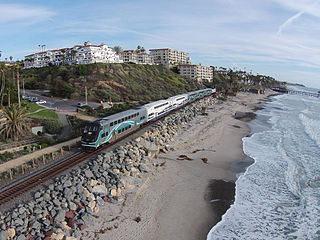
Metrolink is a commuter rail system in Southern California, serving Los Angeles, Orange, Riverside, San Bernardino, and Ventura counties, as well as to Oceanside in San Diego County. The system consists of eight lines and 67 stations operating on 547 miles (880 km) of track. Arrow is operated under a contract with the San Bernardino County Transportation Authority (SBCTA).

Los Angeles Union Station is the main railroad station in Los Angeles, California, and the largest railroad passenger terminal in the Western United States. It opened in May 1939 as the Los Angeles Union Passenger Terminal, replacing La Grande Station and Central Station.

The Metrolink Ventura County Line is a commuter rail line serving Ventura County and the San Fernando Valley in Los Angeles County and the City of Los Angeles, in the Southern California system. The line is the successor of the short lived CalTrain commuter rail line.
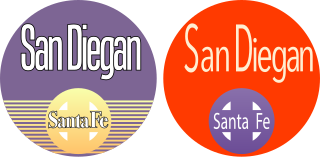
The San Diegan was one of the named passenger trains of the Atchison, Topeka and Santa Fe Railway, and a “workhorse” of the railroad. Its 126-mile (203-kilometer) route ran from Los Angeles, California south to San Diego. It was assigned train Nos. 70–79.

Amtrak California is a brand name used by the California Department of Transportation (Caltrans) Division of Rail for three state-supported Amtrak regional rail routes in California – the Capitol Corridor, the Pacific Surfliner, and the San Joaquins – and their associated connecting network of Amtrak Thruway transportation services.
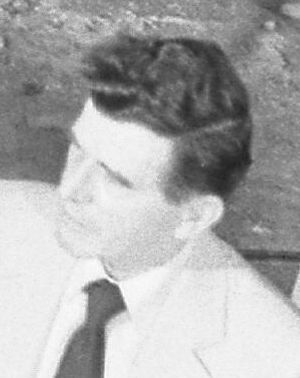
Baxter Ward Schwellenbach was a television news anchor who served two terms on the Los Angeles County Board of Supervisors. Prior to his election on the board, he ran third in an unsuccessful bid to unseat Sam Yorty for Mayor of Los Angeles in 1969.

The GE P30CH was one of the first brand-new diesel-electric locomotives built for Amtrak by General Electric during Amtrak's early years. The design was based on the GE U30C, but had a cowl carbody like its EMD competitors. Amtrak operated them between 1975 and 1992.
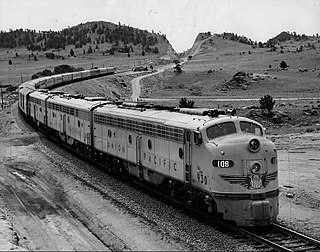
The Challengers were named passenger trains on the Union Pacific Railroad and the Chicago and North Western Railway. The economy service ran between Chicago, Illinois, and the West Coast of the United States. The trains had full Pullman service and coach seating and were an attempt to draw Depression-Era riders back to the rails. Food service was advertised as "three meals for under a dollar a day."

Chatsworth station is an intermodal passenger transport station in the Los Angeles neighborhood of Chatsworth, California, United States. It is served by Amtrak intercity rail service, Metrolink commuter rail service, Los Angeles Metro Busway bus rapid transit, and several transit bus operators.
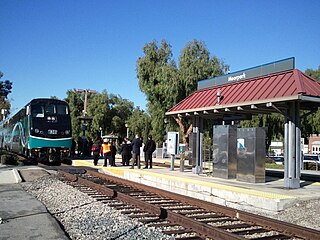
Moorpark station is a passenger rail station in the city of Moorpark, California. Service commenced in 1983 as an infill station on the short-lived CalTrain line. The station was rebuilt in 1992 to accommodate the new Metrolink Ventura County Line commuter trains. Service on that line began on October 26, 1992; Amtrak's Santa Barbara–San Diego San Diegan trains had begun stopping there the day before.
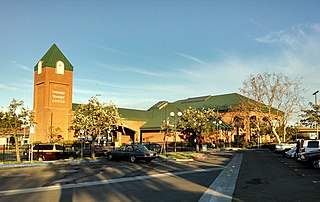
The Oxnard Transit Center is an intermodal transit center in downtown Oxnard, California. It is served by Amtrak Coast Starlight and Pacific Surfliner intercity service plus Metrolink Ventura County Line commuter service.

The Irvine Transportation Center is a passenger rail and bus terminal in the Irvine Spectrum district of southeastern Irvine, California, United States. Located on the southwest end of the decommissioned Marine Corps Air Station El Toro, it is served by Amtrak California's Pacific Surfliner route, two Metrolink commuter rail lines, and multiple Orange County Transportation Authority bus routes.
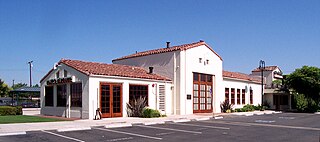
Orange station, formally the Orange Transportation Center, is an intermodal transit station in Orange, California. It serves Metrolink trains as well as Orange County Transportation Authority buses. The station is located at the site of two former Atchison, Topeka and Santa Fe Railway combination depots. The present depot structure was dedicated on May 1, 1938, and was closed with the Santa Fe's discontinuation of passenger service in 1971. The building was granted historic landmark status by the City on November 15, 1990.

Commerce station is a Metrolink rail station in the city of Commerce, California. It is served by Metrolink's Orange County Line running from Los Angeles Union Station to Oceanside. The Metrolink 91 Line from Los Angeles Union Station to Riverside shares the track with the Orange County Line however, no 91 Line trains actually serve the Commerce station. On weekdays, this station is served by eight Orange County Line trains, four in the peak direction of travel during the two peak periods each weekday. There is no midday, reverse-peak, or weekend service to this station.
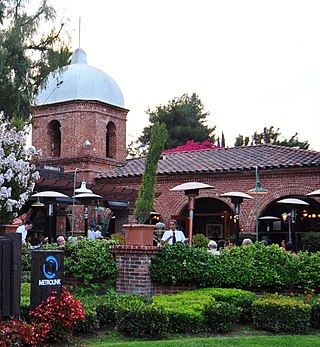
San Juan Capistrano station is a train station in San Juan Capistrano, California, United States served by Amtrak, the national railroad passenger system, and Metrolink, a commuter railroad. The station has a single side platform serving the single track of the SCRRA's Orange Subdivision.

The San Joaquin Daylight was a Southern Pacific passenger train inaugurated between Los Angeles and San Francisco's Oakland Pier by way of the San Joaquin Valley and Tehachapi Pass on July 4, 1941. Travel times were between 12 hours (1970) and 14 hours (1944). It operated until the advent of Amtrak in 1971.

The California Car is the first generation of intercity railcars owned by the California Department of Transportation (Caltrans) and operated by Amtrak under the Amtrak California brand on intercity corridor routes in Northern and Central California. The cars were built in the mid-1990s for the Caltrans Division of Rail by Morrison–Knudsen and the American Passenger Rail Car Company (Amerail). The cars are similar in exterior dimensions to Amtrak's Superliner, but original in design to provide rolling stock suitable for California intercity services up to six hours, with more frequent stops than most other Amtrak routes. All cars were overhauled by Alstom at its Mare Island facility between 2009 and 2012.
References
- ↑ Smith, Ed (October 18, 1982). "87 Take Inaugural Oxnard-to-LA Train". Oxnard Press-Courier . Retrieved August 9, 2013.
- 1 2 3 4 5 Hobbs, Charles P. (2014). Hidden History of Transportation in Los Angeles. The History Press. ISBN 1-6261-9671-0.
- 1 2 "Will El Camino Become El Igloo?". Pacific News (249): 5. April 1984. Archived from the original on 2016-03-04.
- ↑ Jones, Jack and Rich Connell (April 10, 1985). "'Baxter's Choo-Choo' to Chug Chug in Mexico: Supervisors Giving County's Idle Train a One-Way Ticket". Los Angeles Times . Retrieved 1 February 2015.
- ↑ Randall, W. David (1978). Railway Passenger Car Annual, Volume 4, 1978-1979. RPC Publications.
- ↑ Scribbins, Jim (1970). The Hiawatha Story. Milwaukee, Wisconsin: Kalmbach Publishing Company. p. 263. LCCN 70107874. OCLC 91468.